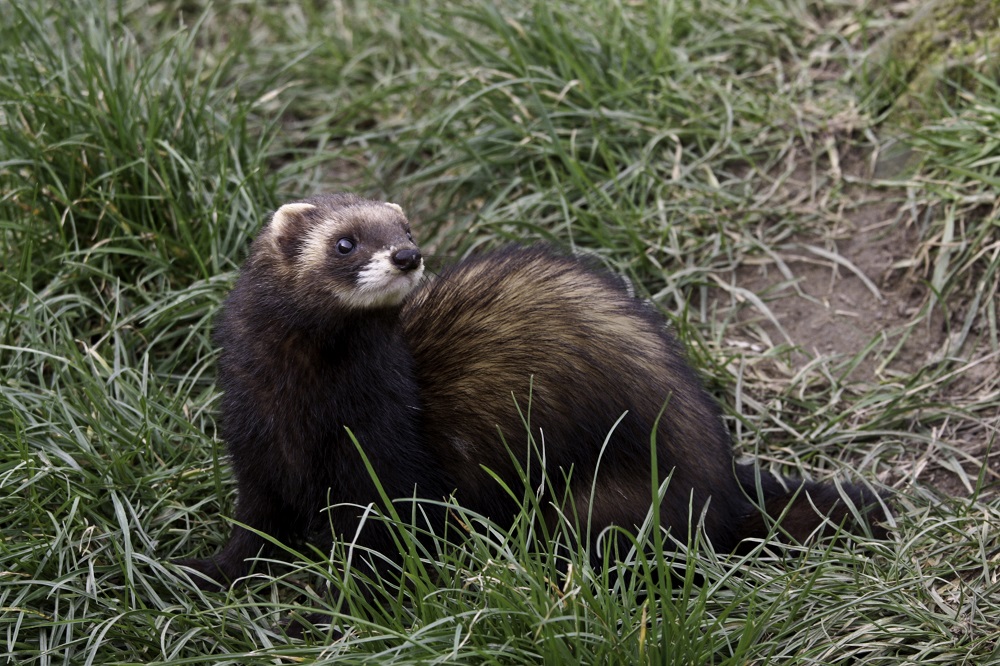Polecats and rat poison

Status
Trapped almost to extinction in 19th century, now recovering
Population
46,000
Scientific name
Mustela putorius
Funding for this project has now finished
Once common across Britain, polecats declined during the 19th Century due to a combination of woodland clearance, trapping and predator controls.
The problem
By 1915 the largest population of polecats was left in central Wales. Since the 1950s they have been recovering their former range and are now present across much of England, from Devon to Kent, Suffolk and Lancashire with much expansion having taken place since 1990.
Previous research found that polecats are at risk from exposure to second-generation anti-coagulant rodenticides. This is because polecats eat rats, particularly in the winter, and rats are routinely controlled using a range of rodenticides. If a polecat consumes a rat that has itself eaten a bait, it too may be exposed to the rodenticide. This may lead to mortality or a range sub-lethal effects. Now that polecats are more widespread across the country, it is time to find out more about how likely they are to be affected by this issue.
The solution
Using approximately 300 polecat carcasses collected as part of The Vincent Wildlife Trust’s 2014-15 National Polecat Survey, we will be running tests on livers to assess the level of exposure to different rodenticides. We will also be analysing the whiskers from the same animals to find out more about their foraging ecology. By combining the analysis of what polecats eat with levels of exposure to rodenticides, we will be able to assess the risk that polecats face across their range at different times of year. This will enable us to make recommendations about future policy and practice to minimise the impact of rat management practices on polecats.
Update
Monitoring exposure of polecats to rodenticides in Britain
By Katie Sainsbury
By the beginning of the 20th century the polecat had almost been extirpated from Great Britain due to intensive predator controls. The only viable population remaining was in west Wales. Due to a combination of reduction in predator management, the recovery of rabbits after myxomatosis and legal protections, polecats have made a remarkable recovery, expanding across Wales and much of central and southern England.
As polecats have expanded their range, the nature of the threats they face has changed. Anticoagulant rodenticides, introduced in the 1950s, are now very widely used to control rodents. Predators, such as polecats, are exposed to these compounds as they consume target and non-target prey that has eaten rodenticide bait. A study in the 1990s found that approximately 30% of polecats had traces of one or more rodenticides in their livers. As polecats have expanded so rapidly in the last 20 years and rodenticides have become more toxic and increasingly widely used, we decided that it was timely to revisit the levels of exposure in Britain’s polecats.
In our study, supported by PTES, we found that 79% of polecats collected from across their range in England and Wales had detectable levels of one or more rodenticides in their livers. Some of this increase was probably due to improvements in the analytical techniques for detecting rodenticides, but even when we took this into account we still identified a 1.7 fold increase in the rate of rodenticide detection in polecats between the 1990s and today.
An obvious conundrum remains; in spite of this widespread exposure, polecat recovery appears to be ongoing. Equally, although we frequently detect rodenticides in road-killed polecats, we cannot know the extent of mortality associated with exposure, if any, as animals are likely to die out of sight. It is possible that rodenticides are hampering the species’ recovery or may do so in some parts of their potential future range. We also know that rodenticides are markedly inhumane, and so minimising exposure will be good for animal welfare as well as conservation of polecats and other predators.
Surprisingly little is known about the details of rodenticide usage in different landscapes: how much bait is used, how this varies by time of year and where the bait is deployed. So our next steps will be to carry out a risk assessment to explore how differences in usage practices might affect the risks of exposure and how we might therefore reduce any impacts on polecats and other wildlife.
Thank you to all our donors who helped us fund this work. You can help us support more projects like this with a donation today:
